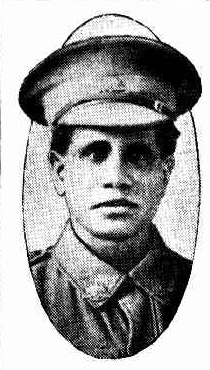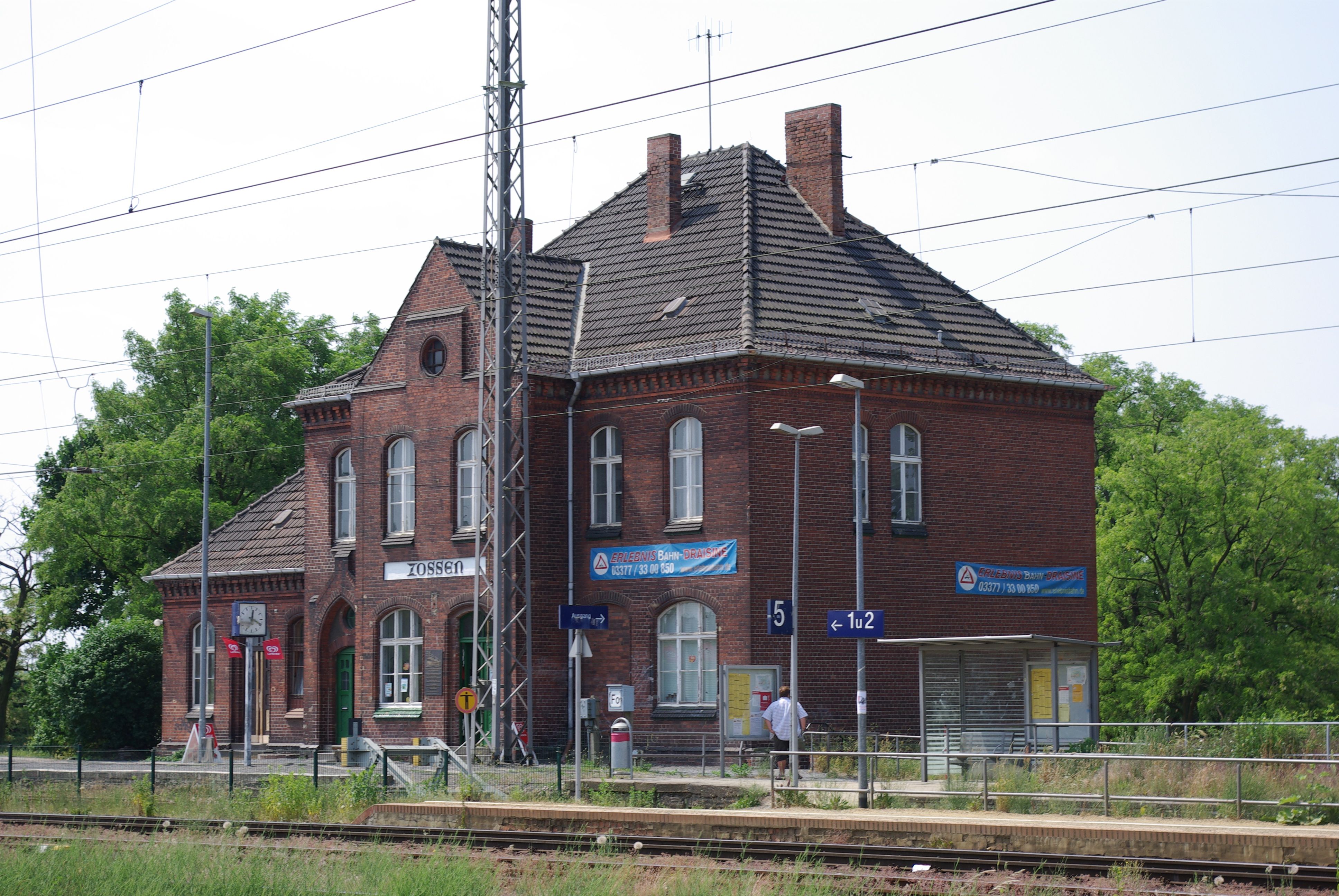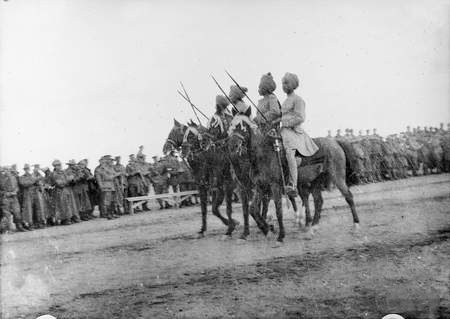|
Halbmondlager
The (known in English as the "Half Moon Camp") was a prisoner-of-war camp in Wünsdorf (now part of Zossen), Germany, during the First World War. The camp housed between 4,000 and 5,000 Muslim prisoners of war who had fought for the Allied side. The intended purpose of the camp was to convince detainees to wage jihad against the United Kingdom and France. To that end, "detainees lived in relative luxury and were given everything they needed to practise their faith". It was the site of the first mosque to be built in Germany, a large and ornate wooden structure finished in July 1915. The mosque, modelled on the Dome of the Rock, was demolished in 1925–26 owing to disrepair. About 80 Sikh prisoners and Hindus from British India were also held in the camp, as well as around 50 Irishmen, and two Australian Aboriginal soldiers ( Roland Carter and Douglas Grant). A subcamp, known as (Camp of Indians), was established to house prisoners from India who were not openly pro-Brit ... [...More Info...] [...Related Items...] OR: [Wikipedia] [Google] [Baidu] |
Roland Carter
Roland Winzel Carter (1892–1960) was an Indigenous Australian who was born in Raukkan, South Australia, and was the first of the Ngarrindjeri people to enlist in the First Australian Imperial Force to fight in World War I. Carter was wounded and captured during combat at Noreuil in northern France on 2 April 1917. He was initially held as a prisoner of war at Zerbst in Germany and later at the Halbmondlager POW camp where he and Douglas Grant were the only Australian aboriginal soldiers in a camp intended principally for the holding of Moslem prisoners of war. Following the war, Carter was repatriated to England England is a country that is part of the United Kingdom. It shares land borders with Wales to its west and Scotland to its north. The Irish Sea lies northwest and the Celtic Sea to the southwest. It is separated from continental Europe b ... and then to South Australia where he returned to Raukkan where he lived until his death. References Further rea ... [...More Info...] [...Related Items...] OR: [Wikipedia] [Google] [Baidu] |
Douglas Grant
Douglas Grant (1885 – 4 December 1951) was an Aboriginal Australian soldier, draughtsman, public servant, journalist, public speaker, and factory worker. During World War I, he was captured by the German army and held as a prisoner of war at Wittenberg, and later at Wünsdorf, Zossen, near Berlin. Early life and career Grant was born around 1885 into the rainforest Indigenous Nations of north Queensland near Malanda on the Atherton Tablelands. Grant's repatriation file (Service Number 6020) records his birth as 5 January 1887. In 1887, as an infant orphaned as a result of a massacre of Aboriginal people by colonial police during the Australian Frontier Wars, he was 'rescued' by taxidermists Robert Grant and E.J. Cairn, who were in the region on a collecting expedition for the Australian Museum. The Aboriginal child was later fostered and renamed Douglas by Robert Grant and his wife Elizabeth. Then, contrary to the laws of the time they smuggled him aboard the steamer ship ... [...More Info...] [...Related Items...] OR: [Wikipedia] [Google] [Baidu] |
Zossen
Zossen (; hsb, Sosny) is a German town in the district of Teltow-Fläming in Brandenburg, about south of Berlin, and next to the B96 highway. Zossen consists of several smaller municipalities, which were grouped together in 2003 to form the city. Geography Since the 2003 municipal reform, Zossen consists of the following districts and municipalities: History Zossen, like most places in Brandenburg, was originally a Slavic settlement. Its name (Upper Sorbian: ''Sosny'') may derive from ''Sosna'' meaning pine, a tree quite common in the region. In 1875, Zossen railway station opened on the railway line from Berlin to Dresden and the Prussian military railway to the artillery range at Kummersdorf-Gut in present-day Am Mellensee. Between 1901 and 1904, Zossen adopted the use of different high-speed vehicles, such as electric locomotives and trams, for transportation to and from Berlin-Marienfelde. These vehicles were powered by an alternating current of 15 kV and used a variable ... [...More Info...] [...Related Items...] OR: [Wikipedia] [Google] [Baidu] |
Wünsdorf Mosque
Zossen (; hsb, Sosny) is a German town in the district of Teltow-Fläming in Brandenburg, about south of Berlin, and next to the B96 highway. Zossen consists of several smaller municipalities, which were grouped together in 2003 to form the city. Geography Since the 2003 municipal reform, Zossen consists of the following districts and municipalities: History Zossen, like most places in Brandenburg, was originally a Slavic settlement. Its name (Upper Sorbian: ''Sosny'') may derive from ''Sosna'' meaning pine, a tree quite common in the region. In 1875, Zossen railway station opened on the railway line from Berlin to Dresden and the Prussian military railway to the artillery range at Kummersdorf-Gut in present-day Am Mellensee. Between 1901 and 1904, Zossen adopted the use of different high-speed vehicles, such as electric locomotives and trams, for transportation to and from Berlin- Marienfelde. These vehicles were powered by an alternating current of 15 kV and used a ... [...More Info...] [...Related Items...] OR: [Wikipedia] [Google] [Baidu] |
Berliner Zeitung
The ''Berliner Zeitung'' (, ''Berlin Newspaper'') is a daily newspaper based in Berlin, Germany. Founded in East Germany in 1945, it is the only East German paper to achieve national prominence since reunification. It is published by Berliner Verlag. History and profile ''Berliner Zeitung'' was first published on 21 May 1945 in East Berlin. The paper, a center-left daily, is published by Berliner Verlag. After the fall of the Berlin Wall, the paper was bought by Gruner + Jahr and the British publisher Robert Maxwell. Gruner + Jahr later became sole owners and relaunched it in 1997 with a completely new design. A stated goal was to turn the ''Berliner Zeitung'' into "Germany's ''Washington Post''". The daily says its journalists come "from east and west", and it styles itself as a "young, modern and dynamic" paper for the whole of Germany. It is the only East German paper to achieve national prominence since reunification. In 2003, the ''Berliner'' was Berlin's largest subscr ... [...More Info...] [...Related Items...] OR: [Wikipedia] [Google] [Baidu] |
Mosque Of The Bois De Vincennes
A mosque (; from ar, مَسْجِد, masjid, ; literally "place of ritual prostration"), also called masjid, is a place of prayer for Muslims. Mosques are usually covered buildings, but can be any place where prayers (sujud) are performed, including outdoor courtyards. The first mosques were simple places of prayer for Muslims, and may have been open spaces rather than buildings. In the first stage of Islamic architecture, 650-750 CE, early mosques comprised open and closed covered spaces enclosed by walls, often with minarets from which calls to prayer were issued. Mosque buildings typically contain an ornamental niche (''mihrab'') set into the wall that indicates the direction of Mecca (''qiblah''), ablution facilities. The pulpit (''minbar''), from which the Friday (jumu'ah) sermon (''khutba'') is delivered, was in earlier times characteristic of the central city mosque, but has since become common in smaller mosques. Mosques typically have segregated spaces for men and w ... [...More Info...] [...Related Items...] OR: [Wikipedia] [Google] [Baidu] |
Friedhof Halbmondlager 2
*
{{disambig ...
Friedhof is German for '' cemetery''. See: * List of cemeteries in Germany ** List of cemeteries in Berlin *** Städtischer Friedhof III *** Weißensee Cemetery *** Zentralfriedhof Friedrichsfelde * Friedhof Fluntern, Fluntern Cemetery, Zürich, Switzerland * Friedhof von Ziegelskoppel, Kopli cemetery, Kopli, Estonia See also * Hugo Friedhofer Hugo Wilhelm Friedhofer (May 3, 1901May 17, 1981) was an American composer and cellist best known for his motion picture scores. Biography Hugo Wilhelm Friedhofer was born in San Francisco, California, United States. His father, Paul, was a ... [...More Info...] [...Related Items...] OR: [Wikipedia] [Google] [Baidu] |
Middle Eastern Theatre Of World War I
The Middle Eastern theatre of World War I saw action between 29 October 1914 and 30 October 1918. The combatants were, on one side, the Ottoman Empire (including the majority of Kurdish tribes, a relative majority of Arabs, and Caucasian ''Tatars''), with some assistance from the other Central Powers; and on the other side, the British (with the help of Jews, Greeks, Assyrians, some Kurdish tribes, and many Arabs, along with Hindu and Muslim colonial troops from India), the Russians (with the help of Armenians, Assyrians, and occasionally some Kurdish tribes) and the French (with its North African and West African Muslim colonial troops) from among the Allied Powers. There were five main campaigns: the Sinai and Palestine Campaign, the Mesopotamian Campaign, the Caucasus Campaign, the Persian Campaign, and the Gallipoli Campaign. There were also several minor campaigns: Arab Campaign, and South Arabia Campaign. Both sides used local asymmetrical forces in the region. ... [...More Info...] [...Related Items...] OR: [Wikipedia] [Google] [Baidu] |
Military Operations In North Africa During World War I
Conflicts took place in North Africa during World War I (1914–1918) between the Central Powers and the Entente and its allies. The Senussi of Libya sided with the Ottoman Empire and the German Empire against the British Empire and the Kingdom of Italy. On 14 November 1914, the Ottoman Sultan proclaimed a jihad and sought to create a diversion to draw British troops from the Sinai and Palestine Campaign. Italy wished to preserve its gains from the Italo-Turkish War. The Senussi Campaign took place in North Africa from 23 November 1915 to February 1917. In the summer of 1915, the Ottoman Empire persuaded the Grand Senussi Ahmed Sharif to attack British-occupied Egypt from the west, raise jihad and encourage an insurrection in support of an Ottoman offensive against the Suez Canal from the east. The Senussi crossed the Libyan–Egyptian border at the coast in November 1915. British imperial forces withdrew at first and then defeated the Senussi in several engagements, includin ... [...More Info...] [...Related Items...] OR: [Wikipedia] [Google] [Baidu] |
German Army (German Empire)
The Imperial German Army (1871–1919), officially referred to as the German Army (german: Deutsches Heer), was the unified ground and air force of the German Empire. It was established in 1871 with the political unification of Germany under the leadership of Prussia, and was dissolved in 1919, after the defeat of the German Empire in World War I (1914–1918). In the Federal Republic of Germany, the term ' identifies the German Army, the land component of the '. Formation and name The states that made up the German Empire contributed their armies; within the German Confederation, formed after the Napoleonic Wars, each state was responsible for maintaining certain units to be put at the disposal of the Confederation in case of conflict. When operating together, the units were known as the Federal Army ('). The Federal Army system functioned during various conflicts of the 19th century, such as the First Schleswig War from 1848–50 but by the time of the Second Schleswig Wa ... [...More Info...] [...Related Items...] OR: [Wikipedia] [Google] [Baidu] |
Humboldt University Of Berlin
Humboldt-Universität zu Berlin (german: Humboldt-Universität zu Berlin, abbreviated HU Berlin) is a German public research university in the central borough of Mitte in Berlin. It was established by Frederick William III on the initiative of Wilhelm von Humboldt, Johann Gottlieb Fichte and Friedrich Ernst Daniel Schleiermacher as the University of Berlin () in 1809, and opened in 1810, making it the oldest of Berlin's four universities. From 1828 until its closure in 1945, it was named Friedrich Wilhelm University (german: Friedrich-Wilhelms-Universität). During the Cold War, the university found itself in East Berlin and was ''de facto'' split in two when the Free University of Berlin opened in West Berlin. The university received its current name in honour of Alexander and Wilhelm von Humboldt in 1949. The university is divided into nine faculties including its medical school shared with the Freie Universität Berlin. The university has a student enrollment of around 32 ... [...More Info...] [...Related Items...] OR: [Wikipedia] [Google] [Baidu] |
Wilhelm Doegen , the Dutch national anthem
{{Disambiguation ...
Wilhelm may refer to: People and fictional characters * William Charles John Pitcher, costume designer known professionally as "Wilhelm" * Wilhelm (name), a list of people and fictional characters with the given name or surname Other uses * Mount Wilhelm, the highest mountain in Papua New Guinea * Wilhelm Archipelago, Antarctica * Wilhelm (crater), a lunar crater See also * Wilhelm scream, a stock sound effect * SS ''Kaiser Wilhelm II'', or USS ''Agamemnon'', a German steam ship * Wilhelmus "Wilhelmus van Nassouwe", usually known just as "Wilhelmus" ( nl, Het Wilhelmus, italic=no; ; English translation: "The William"), is the national anthem of both the Netherlands and the Kingdom of the Netherlands. It dates back to at least 1572 ... [...More Info...] [...Related Items...] OR: [Wikipedia] [Google] [Baidu] |








